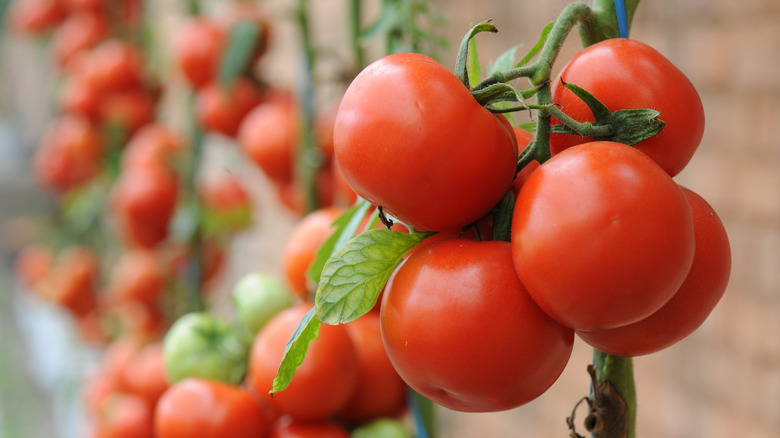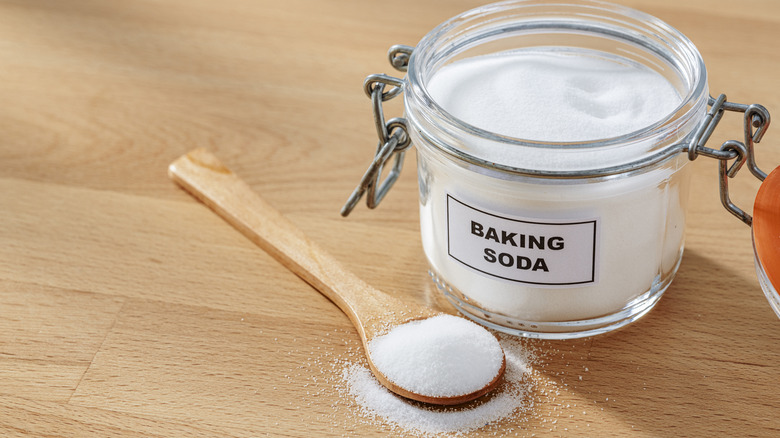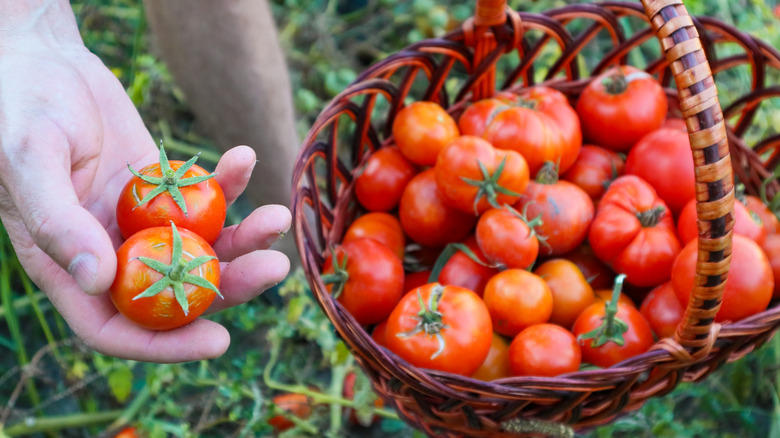The Secret To Growing The Best Tomatoes Is Already Sitting In Your Kitchen Cabinet
There are plenty of ways to use baking soda in your yard and garden, but that simple box sitting in your pantry can actually help make your tomato plants the best they can be. When used correctly, this kitchen staple helps solve a few challenges for tomato growers, from fungal diseases to soil imbalance. Baking soda's alkaline properties help neutralize acidic soil that can slow tomato growth, and its antifungal abilities combat common blights that can take over a tomato plant. Sodium bicarbonate works in different ways depending on how you apply it. As a spray, the mixture creates an inhospitable surface for fungal spores, and when added directly to soil, it helps regulate pH levels that can affect how the tomato plants gain their nutrients.
To get the most out of baking soda, you'll want to start treating your tomato plants early in the growing season. You should expect to see healthier foliage and increased production when using baking soda as part of your plant's care. Unlike commercial fungicides that may contain harsh chemicals, baking soda offers a gentler approach that's safe for organic gardens and doesn't leave any harmful residue on your produce. Its effectiveness against common afflictions like blight and powdery mildew makes it particularly valuable during humid growing seasons when fungal diseases can thrive. It's also very helpful for container-grown tomatoes, where soil conditions can be more controlled.
How baking soda supercharges your tomato plants
Baking soda can benefit plants in a few different ways. Mixing one tablespoon of baking soda with one gallon of water and a few drops of a mild liquid soap will create a spray that can be applied directly to the tomato leaves. This will help stop any fungal spores from germinating and causing a problem to your plants. Do this in the early season before any disease symptoms can appear. Adding baking soda directly to the soil requires just a light dusting around the base of your plants. This will help neutralize acidic conditions that can lock up essential nutrients like calcium and magnesium, which are crucial for preventing blossom end rot and supporting your tomatoes' overall health.
Timing matters as well, early morning sprays are important so that the leaves have time to dry completely before nightfall, reducing moisture-related risks. When adding it to the soil, you should lightly water the area to prevent any powder from blowing away. You may even consider adding baking soda to your regular watering routine to help maintain consistent soil pH levels, using approximately one tablespoon per gallon of water. If you're looking for some tips to grow container tomatoes, mixing a small amount of baking soda with the potting soil before filling helps keep a consistent pH level.
The right way to use baking soda without harming your tomatoes
While there are plenty of benefits to adding baking soda to your tomato plants, improper use can create some problems. Adding too much to the soil can raise its pH level too high, making essential nutrients like iron and manganese less available. Tomatoes prefer a slightly acidic range of 6.0 to 6.8, so always test your soil before beginning any treatments and monitor it after. Never apply baking soda to a drought-stressed plant as the sodium content can increase the lack of moisture issues. You may also notice a yellowing of the leaves if you use the spray too often, this can easily be fixed by adjusting the mixture or spraying it less often. It's also important to rotate treatments with other organic methods, like a compost tea, to maintain a balanced soil ecosystem.
To get the most success out of baking soda, it should be used as part of an overall routine and not just as a standalone solution. Combine it with proper spacing for air circulation, consistent watering, and regular pruning for the best results. Remember that baking soda works as a preventative method, and if fungal disease has already taken hold, more aggressive treatments might be necessary. When used alongside other tips for growing tomatoes in your garden, you'll have beautiful tomatoes growing in no time.


